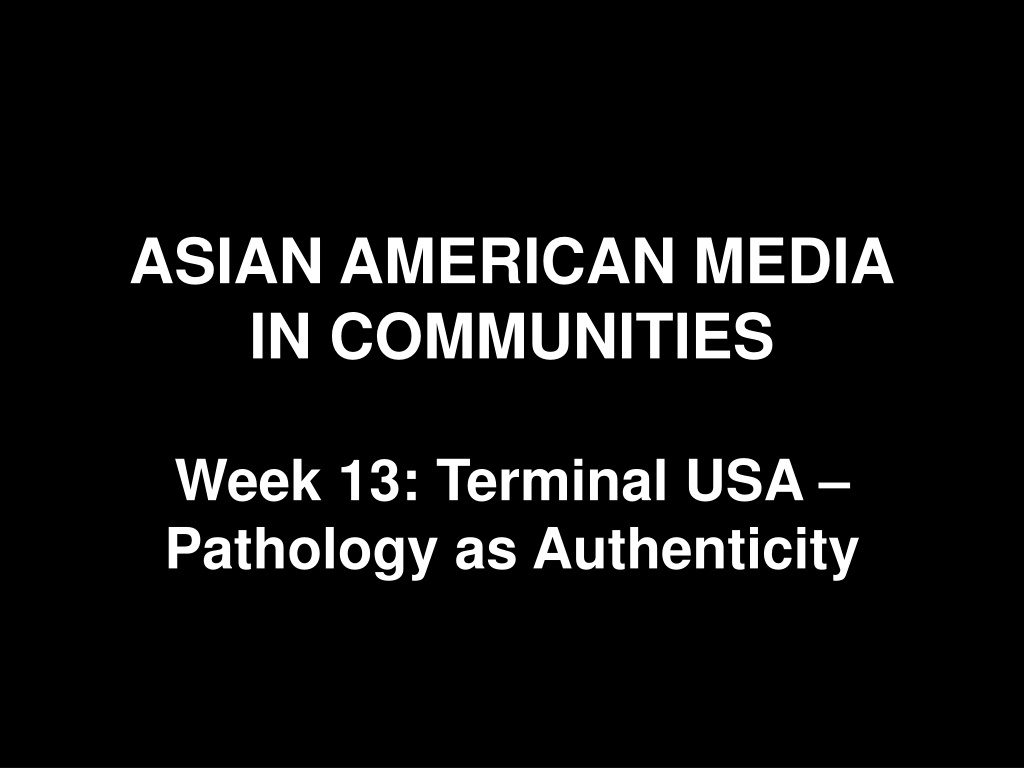Asian American Media in Communities: Terminal USA Pathology as Authenticity
Topics covered include ITVS positive vs. negative images, authenticity, satire, abjection, and the founding of ITVS in 1989. The broadcast of Jon Moritsugu's film Terminal USA on ITVS sparked discourse on race and representation. The show All-American Girl and the struggles faced by Margaret Cho are also discussed, highlighting debates around positive and negative images on television.
Download Presentation

Please find below an Image/Link to download the presentation.
The content on the website is provided AS IS for your information and personal use only. It may not be sold, licensed, or shared on other websites without obtaining consent from the author. Download presentation by click this link. If you encounter any issues during the download, it is possible that the publisher has removed the file from their server.
E N D
Presentation Transcript
ASIAN AMERICAN MEDIA IN COMMUNITIES Week 13: Terminal USA Pathology as Authenticity
Topics: ITVS (Independent Television Services) Positive vs negative images Authenticity Satire, camp, parody Abjection
ITVS ITVS was founded in1989, through the Public Broadcast Act of 1988 Unlike the Program Fund, ITVS was completely controlled by independent producers. (Coalition of Independent Public Broadcasting Producers) Okada calls it different and experimental. (p. 66) It began with 6 million dollars funding from CPB, which it can use to fund productions without creative or editorial input from CPB or PBS
In its first year, ITVS nearly went banrupt Too avant-garde ? It offers A chance for Asian American filmmakers to address the problem of positive image according to Okada ITVS today see web site
In the context of Asian American film and video, the broadcast of Jon Moritsugu s short film Terminal USAon one of ITVS s first programs for PBS, TV Families, especially offered the possibility of a productive discourse on race and representation on television. By virtue of its incisive, sardonic critique of Asian American stereotypes, Terminal USA mobilized the negative image as a more authentic pathway toward an Asian American film and video aesthetics. (p. 55-56)
All-American Girl & Terminal USA Framed within a larger debate around positive and negative images on television: Model minority myth The Cosby Show case study from African Americans on TV A productive negative image (e.g. Eve Oishi s Bad Asians )
All-American Girl Aired in 1994 Stand-up comedy Based on Margaret Cho s Only ran for one season Cho said, in her concert film I m the One That I Want (2000,Dir. Lionel Coleman), that her experience on the show was a nightmare, and led to her anxiety, depression and hospitalization
Enlightened racism? audiences were either grateful for a positive portrayal of Asian Americans or they hated the show s kowtowing to white stereotypes of Asians. (p. 62) The reason why Cho became a stand-up star was because she figured out that the formula for authenticity, as an Asian American, was to be bad. (p. 62)
If the fantasy of The Cosby Show occurred in its unproblematic display of black upward mobility as an escape from black stereotypes, the fantasy of All-American Girl would have been more effective if it had articulated a narrative of escape from stereotypes about Asian Americans, that is, model minority status. (p. 64)
Terminal USA In 1992, Moritsugu was given $9,000 to develop a script for the one of the first ITVS programs TV Families a program that satirized network television sitcoms and dramas and serialized family diversity as an antidote to network television s one dimensional paradigm. (p. 68) The resultant script was awarded a $360,000 production budget
Terminal USA remains Moritsugus most big- budget film. It won awards at film festivals, but was also rejected by a number of local PBS stations. It only screened in 150 out of 210 markets nationwide His other films include Sleazy Rider (1988), Hippy Porn (1991), Mod Fuck Explosion (1994), Fame Whore (1997), Scumrock (2002), and Pig Death Machine (2013). All are made on a shoe- string budget and screened at underground and Asian American film festivals.
Okada compares Terminal USA to All-American Girl, and comments on Moritsugu s use of the abject to provide n effective window into expressions that have hitherto been disallowed in network TV, public television, or other legitimate space. (p. 70) As failures, then, both Moritsugu and Cho successfully saw through to the inevitable trajectory of Asian American expression on stage and screen. (p. 70)
Rather than using injury as a path to recognition, as that which seeks to be looked at, Terminal USA uses the physical abject as a way of challenging a kind of filmmaking that requires recognition as a prerequisite. By pushing the envelope in this way, Terminal USA raises many of the critical issues of his stance as a non Asian American filmmaker. In this way, the value of Terminal USA, and thus ITVS s investment in innovative content, can be linked productively to a politics of resistance against the positive/negative conundrum of racial representation in television. (p. 78)
Film / Video Analysis: Positive vs Negative Images 1. Divide into groups of 2-3 students from your media event groups 2. Select 1-2 works from the program you are working with (AAIM pool or 2016 LAAPFF line-up) 3. Create an analysis modeled after Okada s analysis of All-American Girl and Terminal USA, focusing on how your selected work(s) address the on-going debates of positive
And negative media representation of Asian Americans. 4. Prepare a presentation for the next class: 10- 15 mins. including clip(s) up to 5 mins. 5. Some questions your group may consider: Are what you are seeing positive or negative representations of Asian Americans? Or are they more complex or contradictory images think satire, parody, camps, Kristeva s theory of the abject?
Are discussions of negative/positive images useful in our current mediascape? How has our contemporary social, political, and cultural climate influenced these debates around representation?

